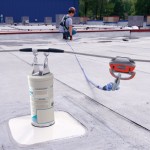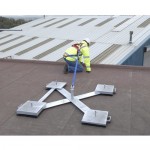Rooftop Lifeline Systems: What Are The Options?
 In our previous blog article, we talked about fall protection equipment for rooftop activities. We discussed how to install and use portable guardrails around unprotected edges and hatches, and how to use skylight railings and screens to protect workers from falling through skylights. In most cases, these types of fall protection systems are the best options for providing safety to workers, and to comply with OSHA regulations. However, there are some situations where rooftop lifelines might be your best option, such as:
In our previous blog article, we talked about fall protection equipment for rooftop activities. We discussed how to install and use portable guardrails around unprotected edges and hatches, and how to use skylight railings and screens to protect workers from falling through skylights. In most cases, these types of fall protection systems are the best options for providing safety to workers, and to comply with OSHA regulations. However, there are some situations where rooftop lifelines might be your best option, such as:
A lifeline system may be your best choice where temporary or permanent guardrails cannot be installed or attached. For example, you might have a pitched roof with slanted sides. In this case, horizontal lifelines can be installed along the level center plane of the roof.
Also, many rooftops on older buildings have “fall through” hazards. There may be weak spots that could collapse under a person’s weight, causing them to fall through. Having a lifeline system in place can prevent injuries from this type of hazard.
Horizontal Lifeline Systems
With horizontal lifeline systems, two or more anchor points are installed and a cable is strung between them. The user attaches a self-retracting lifeline (SRL) to the cable and the SRL to their safety harness. They can then move along the cable from one anchor point to another. The intermediate points are equipped with pass-through brackets and shuttles, so the worker can pass their SRL over the attachment brackets without disconnecting and reconnecting.
This type of solution also can be installed so it runs around the perimeter edge or installed along the horizontal center of a pitched roof, where the sides drop off at an angle. These systems offer the best mobility for rooftop fall protection.
On a perimeter system, for example, the worker has freedom of movement around the entire surface. On a pitched roof, the worker can move along the entire length of the horizontal center, and lower themselves down the slanted sides. In either case, if they fall over the edge, the SRL will arrest their fall.
Single-Point Anchor Points
Single-point anchor points are best used on a flat roof surface. They can be attached at any place on the structure that is inspected and certified to serve as a 5,000-lb anchor point, such as a heavy air-conditioner unit frame. The worker is then tethered to it using a rope grab.
Single-point anchors give the worker more limited mobility than horizontal lifelines. They can only move within the radius of the cable or rope that tethers them to the anchor. For example, if the worker has a 12-foot-long SRL, they can only travel within that 12-foot radius from the tether point. However, if the edge is 14-15 feet from the attachment point, the SRL acts as a restraint system, because the worker can go almost to the edge, but not over it. The anchor and SRL will also protect them from fall-through on older roofs.
Anchor points can usually only support one worker at a time. If a team of workers is required, you will either need multiple anchorages or a horizontal system that runs the length of the roof.
Both are permanent solutions, and both require penetrating the roof for installation by welding or bolting them to the structural members of the building. A permanent solution is best for areas that require ongoing work or inspection, or where employees need to work several times a year.
Portable Deadweight Anchors
 If the work is temporary, it might take only two or three weeks (and the rooftop is one where temporary guardrails cannot be used), a portable non-penetrating deadweight anchor is probably your best option. It lays flat, and does not penetrate the surface. On the other hand, it takes a lot of energy to get it up to the roof. You have to carry the base up, assemble it, and then carry all the weights up to weigh the base down.
If the work is temporary, it might take only two or three weeks (and the rooftop is one where temporary guardrails cannot be used), a portable non-penetrating deadweight anchor is probably your best option. It lays flat, and does not penetrate the surface. On the other hand, it takes a lot of energy to get it up to the roof. You have to carry the base up, assemble it, and then carry all the weights up to weigh the base down.
Some kinds of portable anchors can be attached to H-beams or I-beams. Others come with a base plate that can be attached to a standing seam or metal sheathing roof, or come with vacuum base plates so they can be attached using gas-powered suction.
Keep in mind that workers who use any type of fall arrest system must undergo training to use it, and employers are required to have a fall rescue plan in place for work involving lifelines. Also, all permanent lifeline systems and anchor points must be inspected at least once a year by a competent person.

